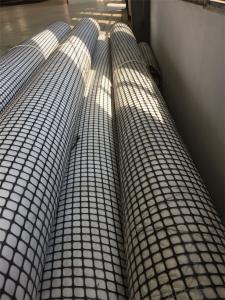Geocells Suppliers UK - Hard Plastic Blind Ditch/Permeable Hard Geotube
- Loading Port:
- Qingdao
- Payment Terms:
- TT OR LC
- Min Order Qty:
- 1000 m
- Supply Capability:
- 150000 m/month
OKorder Service Pledge
OKorder Financial Service
You Might Also Like
Packaging & Delivery
| Packaging Detail: | standard packing or according to client's request |
| Delivery Detail: | 15 days after receiving T/T |
Geocomposite drain pipe technical datas
Item | Square shape | Circular shape | |||||||||
Type | YA7030 | YA1235 | YA1550 | YB60 | YB80 | YB100 | YB150 | YB200 | YB250 | YB300 | |
Outer size(mm) | 70x30 | 120x35 | 120x50 | φ60 | φ80 | φ100 | φ150 | φ200 | φ250 | φ300 | |
Cannular size (mm)≥ | 40x10 | 40x10x2 | 40x20x2 | φ25 | φ45 | φ55 | φ80 | φ120 | φ170 | φ220 | |
Voidage (%)≥ | 70 | ||||||||||
Compress strength (kPa) | Flattening 5% | 70 | 60 | 50 | 85 | 80 | 70 | 50 | 40 | 35 | 30 |
Flattening 10% | 110 | 110 | 70 | 170 | 160 | 140 | 70 | 60 | 55 | 50 | |
Flattening 15% | 150 | 130 | 125 | 220 | 200 | 180 | 100 | 90 | 80 | 70 | |
Flattening 20% | 190 | 180 | 160 | 280 | 250 | 220 | 125 | 120 | 110 | 100 | |
plastic blind ditch
is made of plastic core and outer filtering cloth. In the state of hot melting, it is formed into three-D network structure. It has two shapes: rectangle and round. This kind of pipe has some advantages: good drainage, high pressure resistance, light weight, so it is very popular in some projects.Application:Highway and roadway subgrade,Retaining wall,Landfill,Roof garden,Building foundation,Underground irrigation.
- Q: The ground treatment is full of geogrid is not along the line direction
- Generally paved along the direction of the road
- Q: Can geogrids be used in mining haul roads?
- Yes, geogrids can be used in mining haul roads. Geogrids are commonly used in the construction of haul roads in mining operations to improve road stability, increase load-bearing capacity, and reduce maintenance costs. They provide reinforcement and stabilization to the road base, preventing deformation and rutting caused by heavy mining vehicles.
- Q: Are geogrids resistant to biological clogging?
- Yes, geogrids are resistant to biological clogging.
- Q: How do geogrids improve the performance of geosynthetic-reinforced slopes in seismic zones?
- Geogrids improve the performance of geosynthetic-reinforced slopes in seismic zones by enhancing the stability and resistance to seismic forces. The geogrids act as a reinforcement material, increasing the tensile strength and preventing soil movement during seismic events. They help distribute the seismic forces more evenly, reducing the potential for slope failure and improving overall slope stability.
- Q: Can geogrids be used in reinforced earth structures?
- Yes, geogrids can be used in reinforced earth structures. Geogrids are commonly employed as reinforcement materials in applications such as retaining walls and slopes to enhance the stability and strength of the structure. They provide reinforcement by distributing loads, reducing soil movement, and increasing overall stability.
- Q: How do geogrids enhance the stability of landfill slopes?
- Geogrids enhance the stability of landfill slopes by providing reinforcement and preventing soil erosion. They are placed within the slopes to distribute and transfer the weight of the landfill, reducing the stress on the soil. This helps to prevent slope failure and maintain the integrity of the landfill structure. Additionally, geogrids increase the friction between soil particles, improving the overall stability of the slope.
- Q: Are geogrids suitable for use in contaminated soil conditions?
- Yes, geogrids are suitable for use in contaminated soil conditions. Geogrids are made from durable materials like polyester or polypropylene, which are resistant to chemical degradation. They provide reinforcement and stabilization to the soil, preventing erosion and maintaining integrity even in contaminated environments. Additionally, geogrids can help with soil confinement, which reduces the spread of contaminants. Overall, geogrids are an effective solution for enhancing soil performance in contaminated soil conditions.
- Q: What is the profit margin of the production of Geogrid
- If the product is supplied in accordance with the specifications required by the contractor
- Q: Are geogrids effective in preventing soil erosion on coastal cliffs?
- Yes, geogrids are effective in preventing soil erosion on coastal cliffs.
- Q: How long do geogrids typically last?
- Geogrids typically have a lifespan of 20 to 50 years, depending on factors such as installation quality, environmental conditions, and the specific application they are used for.
Send your message to us
Geocells Suppliers UK - Hard Plastic Blind Ditch/Permeable Hard Geotube
- Loading Port:
- Qingdao
- Payment Terms:
- TT OR LC
- Min Order Qty:
- 1000 m
- Supply Capability:
- 150000 m/month
OKorder Service Pledge
OKorder Financial Service
Similar products
Hot products
Hot Searches
Related keywords























